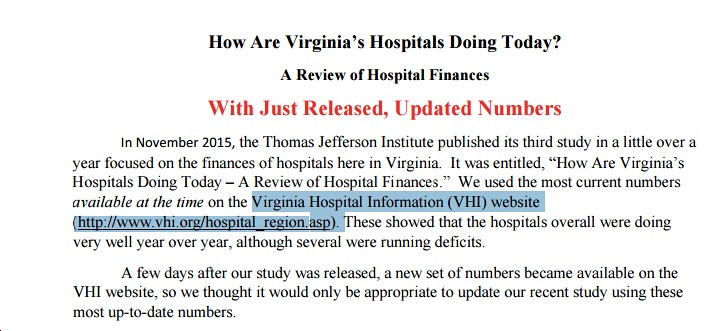 by Lowell
by LowellThe last we mentioned the fine folks at the Thomas Jefferson Institute for Public Policy’s (TJI), it was back in mid-November, with the Virginia Hospital & Healthcare Association (VHHA) refuting the TJI's "misleading" report on the financial condition of Virginia's hospitals. According to the VHHA, this "so-called study" was seriously flawed at best, with "several inaccurate statements," and generally just dead wrong about the state of Virginia's hospitals. As the VHHA's press release said at the time:
Rather than showing across-the-board hospitals profits, as the study implies, what the data actually illustrate is the challenging financial status of many local Virginia hospitals. Considering this so-called study’s origins, a famous quote from President Ronald Reagan is a most appropriate response to it: “There you go again.”Or, how about the classic line from Democratic Sen. Daniel Patrick Moynihan, who famously reminded people in public life that they are entitled to their own opinions but not their own facts. I guess the folks at TJI never learned either of those lessons (or simply don't care).
Now, here's a bit more background on the TJI (also see here) that might help explain their motivation for putting out such erroneous, biased garbage:
The Thomas Jefferson Institute is a libertarian/right-wing think tank committed to "free markets, limited government and individual responsibility." It is funded heavily by the Roe Foundation, a South Carolina-based which provides "financial support to free-market policy groups across the country" and which gives out its annual Roe Award to the likes of Grover Norquist and to others from right-wing groups like the Independence Institute (proud global warming deniers), the Reason Foundation (for years, global warming deniers who received funding from ExxonMobil), and the big-time global warming deniers at the Heartland Institute.
[...]
Finally, it's important to point out that the Thomas Jefferson Institute is a member of the far-far-far-right-wing State Policy Network:
The State Policy Network (SPN) has franchised, funded, and fostered a growing number of "mini Heritage Foundations" at the state level since the early 1990s. It describes itself as a network and service organization for the "state-based free market think tank movement," and its stated mission is "to provide strategic assistance to independent research organizations devoted to discovering and developing market-oriented solutions to state and local public policy issues."...The founding chairman of the board and a major funder was Thomas A. Roe (1927-2000), and the founding executive director was Byron S. Lamm. In the mid-1980s, Roe allegedly told fellow wealthy conservative donor and Heritage Foundation trustee Robert Krieble, "You capture the Soviet Union -- I'm going to capture the states."...Fueled by robust funding from right-wing funders including the Koch brothers, the Bradley Foundation, the anonymous wealthy donors to the donor-advised funds of DonorsTrust, and othersIn short, nobody should believe a word the TJI says about anything. Certainly, the media shouldn't cite this group as a source on healthcare, except to the extent that the TJI's virulently anti-"Obamacare" bias is made clear.
With that background, let's take a look at the TJI's latest "study" (using that word EXTREMELY loosely) on the finances of Virginia's hospitals. There's so much wrong here, it's hard to know where to start. A few points, though:
- First, it's important to stress the enormous value Virginia's hospitals provide to the state, not just in terms of care to patients, but as economic engines that generate billions in positive economic activity ($36 billion) for Virginia; as major employers (115,000 direct jobs); and as supporters of local businesses through their operations.
- As for the TJI “study,” it utterly fails to recognize those benefits, even as it (falsely) claims to understand the nature of hospital finances.
- The TJI "study"'s faulty conclusions are myriad, from basic to more complicated. On the "basic" end of the spectrum, for instance, the "study" erroneously cites “Virginia Hospital Information” (see screenshot above) as the data source from which it reached its conclusions. In fact, the name of that organization is Virginia Health Information (the agency contacted by the state to gather state health care data), not "Virginia Hospital Information" as the TJI erroneously calls it. I mean, hell, it's pretty hard to take seriously the research of an outfit which can’t even properly name the organization it cites as its primary data source. #FAIL
- This basic mistake isn't an aberration, but more like the tip of a very large iceberg of screwups, distortions, etc by TJI. For instance, just as it did in its last "study" of this issue, the TJI continues to count other types of healthcare providers (e.g., Ambulatory Surgey Centers) as hospitals, even though they are not hospitals, and therefore do not provide around-the-clock, and year-round care as hospitals do. This error alone means that TJI’s assessment of Virginia hospitals’ finances is fundamentally flawed from the git-go, because it includes VHI data on non-hospitals in its calculations.
- Also problematic is TJI’s continued reliance on hospitals’ total margins to reach sweeping, yet misinformed, conclusions. Operating margins are by far the better data points to use when evaluating hospitals, because they are a much more accurate reflection of their true financial status that total margins, which include things like hospitals’ reserves and other investment assets. As we all know, the value of investments can fluctuate alongside. For instance, in 2014, the S&P 500 Index return was 11.74%. Total margins also include assets that do not directly impact the day-to-day financial operation and condition of hospitals. Yet that is the standard TJI stubbornly relies on to evaluate hospitals. It's almost like they have a preconceived conclusion and are twisting the data to make them conform. Hmmm...ya think?
- Another big problem: the TJI "study" downplays the fact that year-over-year data continues to show many hospitals across Virginia having negative operating margins. In 2014, for example, 22 of Virginia's 89 hospitals (24.7%) operated in the red. Among rural providers, 13 of 31 acute care hospitals (41.9%), including critical access hospitals, had a negative operating margin last year. And for the hospital fiscal year ending in 2013, 32 of Virginia's 89 hospitals (36%) operated in the red, with a whopping 17 of 37 rural hospitals (46%) also in the red that year. Keep in mind that a 4% operating margin is considered the minimum threshold necessary for hospitals to maintain fiscal stability and provide for capital expenditures. Based on VHI’s 2014 data, 18 of 31 rural hospitals fell below that mark. Statewide, 40 of 89 hospitals were in that category, which includes some with negative margins and others with modestly positive margins.
- Even more strking is that these financial problems exist before deep cuts ($1 billion over six years) in federal funding to hospitals take effect. Yet TJI fail to look forward and acknowledge - let alone factor into its "analysis" - the coming harmful impact of already enacted funding cuts. Those cuts loom as an even greater financial threat to hospital solvency in an era when many hospitals are struggling even before the deepening cuts arrive.

